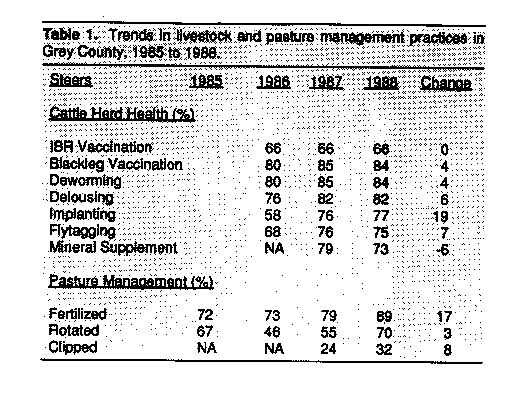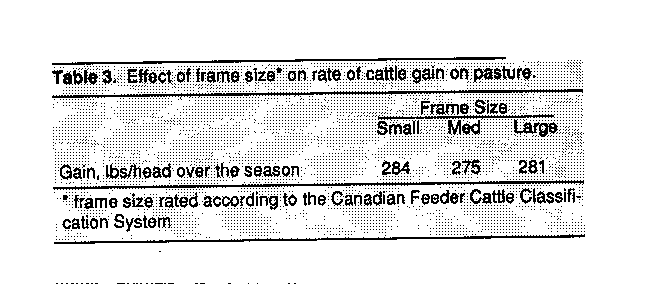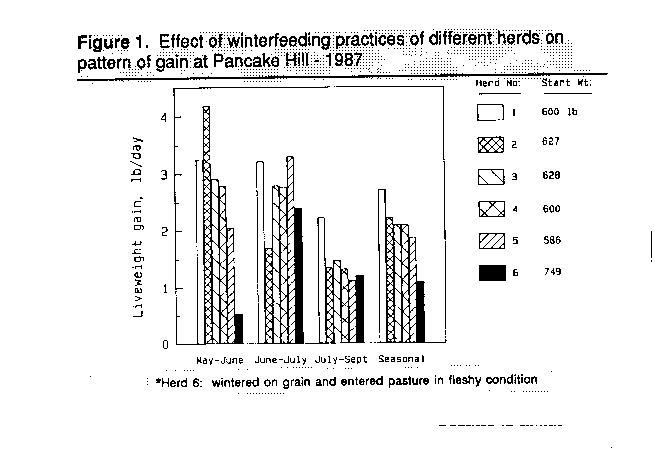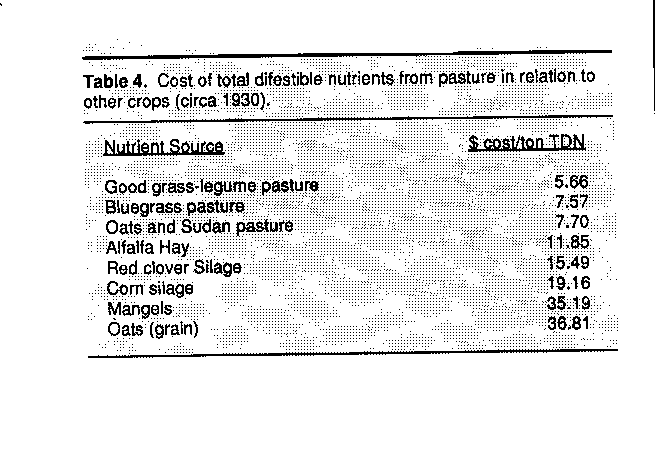
Sustainable Farming Index | Virtual Library | Magazine Rack
Search
| Ecological Solutions Roundtable
By Dr. Ann Clark Assistant Professor, Department of Crop Science, University of Guelph.
In Ontario, as well as much-of North America, pastures have long made an important contribution to agriculture. In 1931, Dr. O. McConkey and colleagues from several departments at the Ontario Agricultural College published a report entitled "Pasture Survey, Province of Ontario, With a Research and Improvement Programme". Some of the salient points made in the report were:
a. In 1931, improved pastures accounted for 3 million acres or 23 % of ail improved land, plus an additional 3.5 million of unimproved land in the province.
b. Relative to Toronto, the dominant pasture region in the west were for beef (1.5 million) and in the east for dairy (1 million acres).
c. Dominant species were Kentucky blue, red top, twitch or quackgrass, timothy, white clover and birds foot trefoil.
d. General condition of the pasture resource was "neglected, low fertility, overgrazed, and of low carrying capacity (1 beast per 4 acres)"
e. Why? Farmers knew that pasture was cheap feed, they did not realize that it could also be high quality feed.
Much has happened since the McConkey era, including heavy emphasis on mechanization, capitalization, annual grain crops, and confinement feeding, with a corresponding decrease in farm numbers and labor force, enterprise diversity, perennial forages and specifically, pasture.
a. As of 1987, improved pastures accounted for 1.1 million acres or 12 % of all improved land in the province. On a percentage basis, improved pasture was half as important to Ontario in 1987 as it was in 1931.
b. Dominant pasture growing regions are still to the west, which contains 38 % improved pasture and supports 40 % of all beef cattle and 33 % of all dairy cows and heifers. To the east, 24 % of the improved pasture supports 20 % of all beef and 28 % of dairy cows and heifers.
c. Improved pastures are still dominated by the same grasses, especially Kentucky bluegrass, timothy, white clover and birdsfoot trefoil, but new species are gaining ground. Newly seeded awards typically include some of the above, plus alfalfa, bromegrass, orchard-grass and creeping red fescue. Interest is increasing in such new crops as perennial ryegrass, the low alkaloid reed canarys and endophyte-free tall fescue.
d. In terms of management, the general condition of most Ontario pastures today is still marginal, compared to that of other crops on arable land. Many operators continue to regard pasture as simply land unsuited to anything else, so you put a sturdy fence around it, turn the cattle out in the spring and collect up what's left in the fall and call it pasture. Two year's ago, an editorial in the Hay and Forage Grower (Jan. 1987) was entitled 'Pasture: our most neglected crop". It mentioned that only 5-10 % of all U.S. pasture (1.1 billion acres) was managed intensively.
e. Why? Pastures have, until recently, been overlooked in modern agriculture for reasons typically including a preference for more capital- and less management-intensive enterprises, and for the higher short-term profits of other enterprises.
But in the last several years, the attitude of North American graziers has shifted significantly. With profit margins shrinking on grain crops, and with increasing concern about animal health and welfare, soil degradation on annually cropped land, and unacceptable side-effects of chemically-intensive agriculture, an increasing number of beef, sheep and even dairy producers are taking a second look at pasture, especially for their higher value land. Based on their own experience, they are coming to regard pasture as a crop, and are taking the time and effort to manage it accordingly.
It has been said that the advent of the Harvestore silo did more to improve alfalfa management and breeding than all the extensionists ever born. When a producer makes the decision to invest in a costly structure to conserve his alfalfa, he then takes seriously the need to put nothing but the best quality forage into the silo. The ensuing process must be managed skillfully to ensure top quality feed.
The same reasoning applies to contemporary pastures. Once a producer decides to pull land out of corn or soybeans or tear up an existing pasture, sow a recommended pasture mixture of certified seed and purchase and install a fencing system, then it clearly behooves him to manage the pasture with the same skill and commitment as any other crop.
Getting the most out of a pasture requires attention not simply to producing the forage, which is the easy part, but especially to managing the grazing to ensure uniform and efficient utilization of forage which is both nutritious and palatable. Top pasture performance also depends on stock that have been prepared to gain on grass, including not simply by working, implanting, and vaccinating, but also by winterfeeding practices, as influencing starting weight and fleshiness. In addition to these pasture, grazing and livestock dimensions, profitable pasture production also requires astute knowledge of marketing.
Pasture management practices which are presently recommended in Ontario are based on time-honored principles known since the time of McConkey, as well as more recent derivations and refinements coming from New Zealand, the U.K., France (Voisin), the U.S., and other countries. At a more local level, a number of groups and individuals have taken the initiative to apply these principles in novel and practical ways in Ontario. Let's have a look at what we have learned in the last few years
Grey County Pasture Survey. Cheryl McArthur, a Red Meat Advisor with the OMAF has conducted annual surveys to document how people in Grey County (western region) are managing their pastures. In 1988, 51 producers representing a total of 2008 steers and 1183 heifers, participated in the fourth such survey (Table 1 )

Over the 3-4 year interval of available data, the percentage of farmers applying improved herd health and pasture management practices has increased, with particular gains in the areas of implanting and fertilizing (Table 1). Ms. McArthur further noted that many producers have increased the fertilizer application rate, have gone to split applications, and are increasingly using a specific pasture analysis rather than whatever was left-over from their other crop applications.
Pasture performance has responded to the improved management practices. For the producers participating in the study, improved practices increased both the stocking rate (22 %) and the average daily gain (9 %), which jointly increased total gain per improved acre by 26 % between 1985 and 1988 (Table 2). By 1988, gains had surpassed those considered good at the time of the Ontario Pasture Competitions in the late 1950's (250 Ib/ac). While potential gains on pasture in Ontario have been shown to be 3 to 4 times higher still, the key question is profitability, rather than productivity.
Because of this survey Grey County producers are learning the beneficial effects of improved livestock and pasture management practices. This type of survey is also valuable to researchers and extensionists, for identification of practices already well accepted and those needing further attention.
In Ontario, 12 Community Pasture Farms were created between 1962 and 1982 to allow local producers to increase stock numbers without having to purchase additional land. As of 1987, a total of 6430 hectares of land carried over 6000 head of full season and shortkeeping stock from a total of 350 beef and dairy producers. Operating costs are recovered from rates determined by local Pasture Boards, based either on weight gains or a flat rate per head. Other groups, such as the Renfrew Cattleman's Association in eastern Ontario, also manage demonstration pastures to benefit local producers.
A recent direction of these locally run pastures has been on-farm demonstration designed to test the benefits of improved livestock and pasture management techniques. Projects undertaken by the various pasture Boards include comparisons of species and fertilizer regimes, pasture renovation methods, and of animal care products, such as fly tags and feed supplements.

Mark Leahy, an extensionist with OMAF, has reported on work done at the Victoria County Community Pasture and at the Pancake Hill Farm in Hastings County. A study which was conducted at the Victoria pasture in 1983 involved a total of 260 steers and heifers and showed that frame size, per se, had little effect on ability to gain on pasture (Table 3).

Thus, selecting for smaller frame animals to encourage grass finishing, or for larger frame animals to encourage grass finishing, or for larger frame animals for specific feedlot markets, should not penalize pasture performance.
A study conducted at Pancake Hill in 1987 demonstrated the effect of body condition or fleshiness, as influenced by winterfeeding practices. Patterns of gain were contrasted among herds from 6 different producers, all of which grazed together on a rotationally managed pasture (Figure 1). Herds 1-4 ranged in starting weight from 600 to 628 Ibs, Herd 5 started at 586 Ibs, while Herd 6 started at 749 Ibs. Herd 1 had been roughed through the winter on hay and started in a lean condition, while Herd 6 was winterfed on grain and arrived in a fleshy condition.
Herd 1, which arrived lean, achieved 346 Ibs/steer or a seasonal rate of gain of 2.7 Ib/day. Herd 5, which started light enough to suggest stunting in yearling calves, achieved 238 lb. or 1.9 Ib/day (31 % less), while Herd 6, which started overly fleshy, achieved only 141 lb. or 1.1 Ib/day (59 % less than Herd 1).
Clearly, ability to gain on grass is influenced by body condition and fleshiness, with either stunted or overly fleshy stock being penalized relative to lean or green stock. This principle has long been known, but the producers of Hastings County have put some numbers to it, showing that even when presented with identical forage and managed on the same pasture, starting body condition can greatly affect returns to the individual producers. When the reasons for such differences are known, comparisons of herd performance among producers may help identify areas for improvement in individual herds.
Pasture Profit. Max and Jean Colwell of Strathmill Farm in eastern Ontario have a 150 crossbred ewe spring-lambing flock. In a recent study funded by the Ontario Sheep Marketing Agency, they compared pasture with grain for profitable lamb production. The results may be surprising.
Back in McConkey's era, a ton of digestible nutrients from good grass-legume pasture cost half as much as that from alfalfa hay and one-third as much as from corn snags (Table 4).

Now, a lot has changed since 1930, including input prices and commodity values. How does pasture compare today? In 1988, the Colwell's old grass pasture produced 280 lb. LWG from lambs, yearlings, and ewes, plus maintenance for dry ewes. Including pasture costs for land, fertilizer, chemical weed control, fencing (over 7 years), and equipment (total $52.74/acre), their cost per pound of gain on pasture was $0.19. Using prevailing feed costs for hay, corn, and soybean meal, in a computerized ration prepared by OMAF, conserved feeds would have cost them $0.28/lb. of gain or 50 % more than on pasture. This cost is only for the feed, and does not include operator time to feed, collect and distribute manure, or other storage and handling costs associated with confinement feeding. Pasture really is cheap feed, as shown by the sheep of Strathmill Farm.

The Northfolk Grazing Management Research Facility was established in 1985 on 50 acres of Class 1, tile-drained soil at the Elora Research Station. From 1986 to 1988, steer gains, pasture species performance, and profitability were compared under four pasture regimes, namely, two sward types (grass vs. grasslegume) each managed under two rotation intensities (4- vs.12 paddock rotation). Each of the 4 treatments were replicated 4 times, making a total of 16,3-acre fields.
A question of great interest to producers is whether beef pasture can compete with alternative grain crops on Class 1 land? Using the treatment with the highest overall gains (4-paddock, grass-legume; averaging 712 Ib/ acre), we extrapolated class 1 land and management costs from the OMAF Farm Management Manual, including fertilizer and land costs for corn and seed and biocide costs for alfalfa. Custom costs for all machinery operations were included, and costs for establishment and for the entire fencing system were amortized over just 3 years. On-pasture and fencing costs totaled about $200/ acre (Table 5). This is a liberal estimate of on-pasture costs, because for example, the fertilizer bill on this grass-legume sward was substantially less than that for corn.
The biggest variable in the whole study was the cost of accessing the cattle, and specifically, the size of the negative selling margin. Using the actual stocking rates and purchase/sale prices for these cattle in each year, the per acre costs of the selling margin varied by a factor of 8, from $46/acre in 1986 to $365/ acre in 1988 (Table 5). Most of this difference came from the difference in the selling margin, from $0.05/lb. in 1986 to 0.30/lb. in 1988 (Table 6). Interest costs per acre almost doubled over the 3 years, due to increases in starting weight, stocking rate, and purchase price. Livestock costs totaled from $187/acre in 1986 to $550/acre in 1988.
After all fixed and variable costs, including a management allowance (5 % of gross), net profit varied as $130/acre in 1986, $138/acre 1987, and a loss of $57/acre in 1988.
Had the selling margin in 1988 been $0.25 instead of $0.30, we would have netted $4.25/acre, so, at the stocking rate we used, just a $0.05 difference in selling margin made a $61/acre difference.
Had the starting weight been 600 lb. instead of 675 lb., the selling margin would have been $40 less per acre, and interest would have been $7 less per acre. Thus, using heavier stock (which didn't gain any better than the lighter ones used in 1986), reduced profit by $47/acre in 1988.
In this experiment, cost per pound of gain varied from $0.64 in 1986 (of which just over half was on-pasture costs) to $1.08 in 1988 (Table 5). In 1988, pasture costs accounted for just about one-quarter of all costs, with three-quarters coming from livestock costs (Table 5). Including just the on-pasture costs, cost per pound of gain varied from $0.33 in 1986 to $0.25 in 1987 to $0.28 in 1 988.


The take-home message from all this is that you can be the best pasture manager in the world and still lose your shirt if you don't know how to buy and sell cattle. It really pays to pencil through your costs before you buy in the spring, to see how much you can afford to spend in the spring and still have a reasonable likelihood of making money. Interest has revived in introducing intensively managed pasture onto higher value land, as well as in improving gains on marginal land. To a large degree, pasture species and management practices today are similar to those used in the time of McConkey. But, contemporary farmers also have new fencing systems, new species, a widening array of proven practices, and an increasingly strong incentive to manage their pastures well.
Editor's note: This article was reprinted with permission from the proceedings of the 1989 Forage and Grassland Conference. University of Guelph. May 22-25. All photos courtesy of Dr. Ann Clark.
Copyright © 1990 REAP Canada